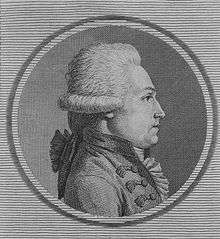Jean-Xavier Bureau de Pusy
Jean-Xavier Bureau de Pusy (born 7 January 1750 at Port-sur-Saône in the department of Haute-Saône – died 2 February 1806 in Genoa, Italy) was a French military engineer and politician, during the French Revolution.[1]
Jean-Xavier Bureau de Pusy | |
|---|---|
| Born | January,7 1750 Port-sur-Saône |
| Died | February,2 1806 (age 56) Genoa, Italy |
| Rank | second lieutenant |

Political career
Deputy of nobility for the bailliage d'Amont in the Estates General of 1789 that became the National Constituent Assembly, Jean-Xavier Bureau de Pusy was three times named president of the National Constituent Assembly:
- from 2 to 24 February 1790;
- from 11 to 24 September 1790;
- from 24 May to 5 June 1791.
He contributed actively to the division of France into 83 departments,[2] in 1790, and with the metric system.
In 1790, he corresponded with Alexander Hamilton.[3]
Military career
On 1 January 1771 he entered the School of Engineering at Mézières as a second lieutenant. He was a military engineer at the Fort de Joux in 1786, in 1789 he was captain with the Royal corps of Engineers.[4]
After the session of the National Constituent Assembly, he resumed as a captain in the engineering corps, and continued to defend the constitutional principles. On January 1, 1792, Louis XVI gave him the Cross of St. Louis.
In 1792, he was a subordinate under Gilbert du Motier, marquis de Lafayette, at Metz. He, Lafayette, and some other officers were taken prisoner by the Austrians near Rochefort when de Pusy asked for rights of transit through Austrian territory on behalf of a group of French officers. This was initially granted, as it had been for others fleeing France, but was revoked when the famous Lafayette was recognized.[5] He was imprisoned by the Austrians at the fortress of Olmütz in 1792. He was released in 1797, under the terms of the treaty of Campo-Formio (18 October 1797).
He the then went to Hamburg. From there he traveled to the United States, where he received a warm welcome as Lafayette companion in misfortune. He was offered vast, land grants on the banks of the Delaware River, but he had not given up on returning to France, and when the consulate government had, after the coup of 18 Brumaire, struck off the list of émigrés members of the National Constituent Assembly who had recognized the sovereignty of the people, he hastened to return.
In 1799, he corresponded with Thomas Jefferson.[6]
Consulate and Empire
On 11 Brumaire X (2 November 1801), the First Consul appointed him the prefect of Allier, and then, on 11 Thermidor X (30 July 1802), that of the Rhône; it showed a very conciliatory spirit, and showed himself able administrator.
He was made a Commandeurs of the Legion of Honour on 25 Prairial XII (14 June 1804). He was appointed prefect of Gênes (Genoa) on 15 Messidor year XIII (4 July 1805); he had to suppress a riot of Parma, and was able to without shedding a drop of blood. He caught an illness that he died from on this exposition.
Family
He was the son of Jean-Baptiste Bureau de Pusy de Port-sur-Saône, conseiller correcteur of the Chambre des comptes of Franche-Comté, and grandson of Pierre-François Choullat. He was the son-in-law of Pierre Poivre. His mother-in-law, Françoise Robin, married Pierre Samuel du Pont de Nemours. His son, Maurice de Pusy (1799–1864), married Mathilde de Lafayette, daughter of Georges de Lafayette and Emilie de Tracy, and granddaughter of General Lafayette and Antoine Destutt de Tracy.
References
- Henri La Fayette Villaume Ducoudray Holstein (1833). Le Glaneur Francais, Number One:. Russell Robbins. pp. 242–244.
- "Bureaux de Pusy, Jean Xavier, 1750–1805. Summary report of the new divisions of the kingdom made to the National Assembly, to the Committee of the Constitution, by Mr. Bureaux of Pusy at the Meeting of Friday 8 January 1790 (Paris, Baudouin)" (PDF). Archived from the original (PDF) on 15 September 2006. Retrieved 24 January 2009.
- Alexander Hamilton, Harold CSyrett, The Papers of Alexander Hamilton, p.18
- "Racine Comteises, Jean-Xavier Bureau de Pusy (1750–1806)". Archived from the original on 16 May 2008. Retrieved 24 January 2009.
- Spalding, Paul S. (2010). Lafayette: Prisoner of State. University of South Carolina Press. ISBN 978-1-57003-911-9., pp. 1–3
- The Papers of Thomas Jefferson, Index, Volume 31: 1 February 1799 to 31 May 1800